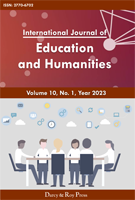Revitalizing Cultural Spaces in Historic Districts based on Immersive Design
DOI:
https://doi.org/10.54097/rakys133Keywords:
Immersive Design, Historical Blocks, Cultural Space Reimagining, Spatial Narrative, Experiential Design, Living HeritageAbstract
As carriers of urban cultural memory, the preservation and revitalization of historical districts has always faced a conflict between the need for authenticity and the need for modern experiences. Some district renovations have suffered from superficial cultural practices, functional homogeneity, and fragmented experiences, making it difficult to achieve a synergistic balance between cultural value and practical value. Taking immersive design as a core perspective, this paper explores approaches to revitalizing cultural spaces in historical districts through literature review, case studies, and field research, drawing on real-world renovation projects such as Yangmeizhuxie Street in Beijing, Pingjiang Road in Suzhou, and Kuanzhai Alley in Chengdu. The study suggests that immersive design can address the challenges of insufficient cultural expression and low audience engagement in historical districts through a framework of "spatial adaptation-content construction-experience optimization-support and support." Specific approaches include: anchoring revitalization with authenticity as the principle, optimizing physical and perceptual environments through spatial strategies, exploring local memories through cultural content, and achieving sustainable development through a multifaceted support mechanism. This study aims to provide practical solutions for the dynamic preservation of cultural spaces in historical districts. It also enriches the theoretical application of immersive design in cultural heritage preservation, providing both theoretical and practical guidance.
Downloads
References
[1] Xu Changjian. Research on the influencing factors of immersive tourism experience in Harbin Chinese Baroque District[D]. Harbin University of Commerce, 2025.
[2] Tahseen E, Al-Jumaily S. Mechanism of revitalizing intangible cultural heritage to revitalize urban space[J]. International Journal of Environment, Engineering and Education, 2020, 2(3): 31-42.
[3] Sun Ting, **T, Huang Yan et al. Restoration of Dunhuang murals: Integrating cultural heritage protection knowledge into immersive virtual reality experience design[J]. International Journal of Human-Computer Interaction, 2024, 40(8): 2019-2040.
[4] He Ziyu. Research on consumption upgrade of tourism and leisure blocks based on immersive experience [D]. Jiangxi University of Finance and Economics, 2023. DOI: 10.27175/d.cnki.gjxcu.2023.000592.
[5] Zhou Yanwei, Cui Zijia, Wang Chenyu. Research on heritage inheritance and revitalization strategies of historical blocks under the perspective of immersive cultural tourism - a case study of West Street in Baoding City [J]. Art and Design (Theory), 2025, 2(06): 76-78. DOI: 10.16824/j.cnki.issn10082832.2025.06.010.
[6] Li Yong. Design and application of virtual reality games in cultural heritage protection [C] // 2024 International Conference on Humanities, Arts, Education and Social Development (HAESD 2024). Atlantis Press, 2024: 12-18.
Downloads
Published
Issue
Section
License
Copyright (c) 2025 International Journal of Education and Humanities

This work is licensed under a Creative Commons Attribution 4.0 International License.

















